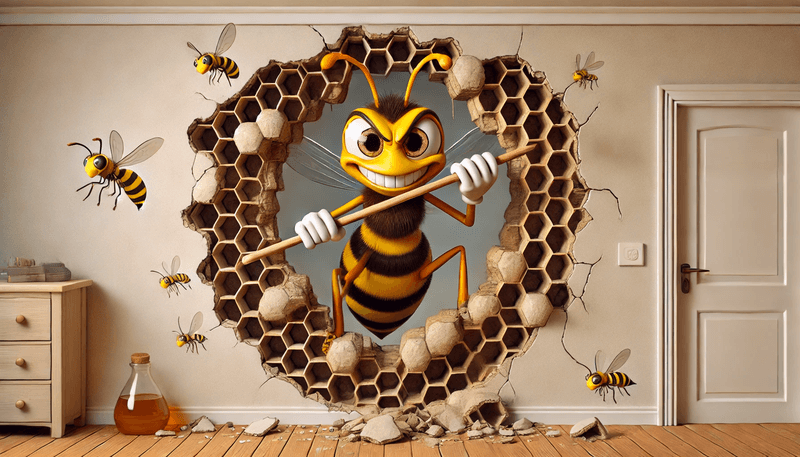
Do Wasp Nests Make a Noise? Click Click Click… Buzz Buzz Buzz!
Have you ever heard strange noises coming from your walls or ceiling? A soft clicking sound or an eerie buzzing noise? You might immediately think you have an electrical problem or even a water leak. But in some cases, these unusual sounds could be a sign of a hidden intruder — a wasp or bee nest!
In this article, we’ll dive into the sounds that wasp nests make, how to tell the difference between wasps and bees based on the noises they produce, and what to do if you discover a noisy nest in your home.
Do Wasps Make a Buzzing Noise?
Unlike bees, wasps are generally quieter insects. You won’t often hear the same constant buzzing sound you would associate with bees. However, there are times when a wasp nest can produce a noticeable noise, especially in hot weather. When temperatures rise, wasps have a clever method of cooling down their nests by fanning it with their wings. This fanning creates a low, humming noise, but it’s usually much subtler than the loud buzzing sounds bees tend to make.
If you ever hear a soft humming coming from a wasp nest, it’s likely because the wasps are trying to regulate the temperature inside. But remember, this humming noise won’t be persistent or as obvious as what you might hear from bees.
Buzzing in the Walls? You Probably Have Bees, Not Wasps
If you hear a constant buzzing sound from inside your walls or above the ceiling, the culprit is most likely not wasps, but bees. Bumblebees, in particular, are known for their noisy behaviour. Their wings beat rapidly, producing a distinctive buzzing sound, and sometimes, you may even hear a chirping noise.
Unlike wasps, bees have a much louder presence when they build a nest inside your home, and their buzzing can be heard more consistently. Based on the noise alone, this can help you determine whether you have a wasp nest or a bee colony.
Although this noise can be distracting or annoying, please remember that bees are not considered pests and bumble bees should be left alone. They are not destructive like wasps, and it is advisable to leave them alone. Their nests finish fairly early in the summer.
The Clicking Noise of a Wasp Nest
So, what about wasps? If they aren’t typically buzzing, what noise do they make? The sound most commonly associated with wasp nests is a clicking, crackling or tapping. Homeowners sometimes mistake this noise for a water leak, especially when the nest is hidden within walls or ceilings.
The clicking sound comes from the wasp larvae inside the nest. This noise is especially noticeable in larger nests with more larvae present. If you’re hearing a repetitive clicking or tapping noise in your walls, there’s a good chance you have a wasp nest nearby.
Is It a Water Leak or a Wasp Nest?
The clicking sound from a wasp nest can be easily confused with the sound of dripping water, leading people to believe they have a plumbing issue. However, in most cases, it’s the sound of wasps working away behind the scenes.
In hot weather, wasps often bring water into the nest to cool it down. They use their bodies to transport the water, sometimes leading to water pooling at the bottom of the nest. This water can eventually seep through the walls or ceiling, staining plasterboard and creating the illusion of a water leak.
If you notice a wet spot on your walls or ceiling near the area where you’ve heard clicking noises, it could be a sign of a wasp nest. Do not attempt to poke or prod the area, especially if the plasterboard feels soft or soggy. The water inside the nest can weaken the plaster, and disturbing it could lead to a mess or even an angry swarm of wasps!
If you suspect a wasp nest is causing noise and water damage, it’s best to contact a professional pest control service. The nest will need to be safely treated to avoid further damage.
How to Repair damage from a Wasp Nest
Once the wasp nest has been dealt with, you may have a stained or damaged ceiling or wall. Before you begin any repairs, letting the affected area dry out completely is important. Wasps bring water into their nests, and the liquid they carry can sometimes be oily as it passes through their bodies during transport.
When the wall or ceiling is dry, use a paint sealer to cover any stains the water leaves. This will prevent the stains from bleeding through when you repaint the area. After the sealer has dried, you can repaint the surface to match the rest of your home.
In Summary: Clicks for Wasps, Buzzes for Bees
If you hear a clicking, crackling or tapping noise from within your walls, it’s most likely a wasp nest. However, if the noise is a constant, loud buzzing, you’re probably dealing with bees, not wasps.
In either case, it’s important to avoid disturbing the nest and to seek help from a professional pest control service to safely remove it. If you notice water damage from the wasps cooling down their nest, dry the area thoroughly and use a paint sealer before repairing it.
So, next time you hear a strange clicking or buzzing in your home, you’ll know what’s making all that noise: click, click, click… buzz, buzz, buzz!
